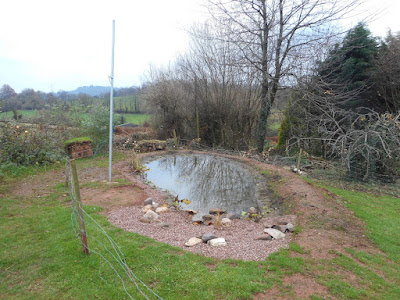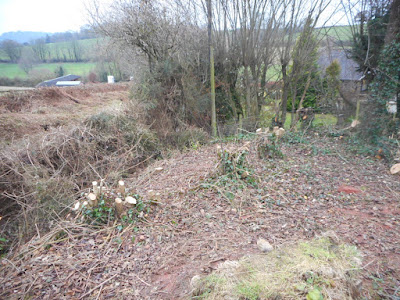As Exeter expands ever closer, as my walks are increasingly restricted by barbed wire, impenetrable fences and ‘Private’ signs, and as fields and hedges are tidied and tamed, I’ve decided to create my own patch of wild nature by doing everything I can, with Frog’s help, to encourage it into our garden. Here’s how we’re doing it.
During the summer, except for the bit near the house where we sit, we let the lawn grow. Ox-eye daisies and Meadow cranesbill, that once upon a time I planted in the flower-beds, escaped to bloom in profusion, and all the low plants like self-heal, that usually never got much of a chance, spread beneath them in a carpet of colour and bees. It all looked and sounded gorgeous and lifted my heart every day. (Unfortunately I wasn’t taking photographs at the time so can’t share it with you.) I was astonished how much could happen in such a short time
In September (I think), after the flowers had set seed, we cut and raked the area. (It’s important not to leave the cuttings as they fertilise the soil, and wildflowers do best on poor soil.)
In October, with professional help, we dug a pond and semi-planted it with appropriate wild flowers. I didn’t want to cram it with plants as I’m keen to see what arrives of its own accord. Apart from anything else, these plants are what will do best. Also, I need to see how much of the bank stays damp in the summer – ie how much the liner intrudes.
 |
| The new pond (The fence is there to stop us and The Dog churning up the mud.) |
Already, birds are using the pond for paddling and drinking. A few weeks ago it froze over, but the middle is very deep (3-4 foot?) so creatures like dragonfly larvae will be able to survive.
The plants are in sacks of soil around the edge, not plastic
pots.
 |
| The sacks of soil around the edge of the pond, with some planting |
There is a good shallow area, as this is where the water is
warmest and tadpoles thrive, and an extensive beach so that amphibians and
other creatures can get out.
 |
| The pond's shallow margin and beach |
To one side of the pond with some second-hand bricks we'd acquired, the pond people created a bug hotel. I’m not sure about it as our banks are full of holes anyway, with bees going in and out of them, and I prefer to keep things as natural as possible. Maybe its position next to the pond is the important factor. I shall monitor it.
 |
| The bug hotel |
They also created this formal log-pile next to the pond as shelter for amphibians and small mammals, which again I’m not sure of
as we already have plenty of untidy piles of logs. We shall
see.
 |
| The tidy log-pile |
With the pond, we viewed our garden in a whole new way. We
saw how dense the trees at the bottom of the garden had become, how much they
obscured our lovely views and how much shade they cast, particularly over the
pond. We did a lot of clearing.
 |
| A cleared area |
The stumps you can see in the picture above will be dug out. They are mostly Field maple which grows fast and big and can't be laid as it's too brittle. It was a bit of a nuisance actually.
We finally got round after 41 years to arranging for these Leylandii to be removed (in January before the nesting season) as they’re not native and everything around them was dark and dead.
 |
| The Leylandii (in the background) |
As firs don’t re-sprout like broadleaved trees do, we’ll be able to leave a good stump. This should be colonised by ivy, valuable cover for wildlife and a source of nectar and berries in autumn and winter when there’s not much else around.
At the same time these Willow (I think) trees, grown tall and spindly in
their efforts to reach the light, will be coppiced so that they bush out. That
way they’ll provide thicker, safer places for birds to nest and roost, be a better screen between us and our neighbours, and return to us our view of the horizon.
 |
| Trees for coppicing |
I envisage the area as a small dappled wood as it already
has Holly, Elder, Blackthorn and Wild cherry. I’ll see how these trees change with
the increased light and space and if necessary, after I’ve watched the spot for a
year or so, I may plant one or two more trees. We had an enormous flock of
fieldfares (refugees from the cold further north) scoping our garden for a week
in November and I felt awful that we didn’t have any food for them as the few
berries we do have were all gone. A hawthorn or a crab-apple might help.
Fired with enthusiasm and while the digger was on site, we cleared the shrub bed next to our terrace. Not only were the shrubs non-native, but they stopped us seeing our new wildflower meadow. We seeded it with a (native) wildflower-meadow mix which included a plant called Yellow rattle. This steals nutrition from grass, thus deterring the grass and allowing wildflowers to thrive, and is a vital ingredient of wildflower meadows. I’m hoping the Yellow rattle will spread to the bits that were once lawn.
 |
| The ex-shrubbery, soon to be a wildflower meadow. (The pole is one of three that hold up our shade-sail in the summer.) |
We also sowed wildflower-meadow seed on all the muddy patches around the pond and on the bald patches that had arisen in the rest of the garden because of the traffic to and fro.
Scrub (shrubs) is an important wildlife habitat so we’ve left our other shrubbery, even though it’s non-native and a bit of a disaster by conventional standards (overgrown with brambles and nettles, part dead, mis-shapen etc etc). I’ll work out what to do with it in due course.
 |
| The overgrown shrubbery (with cuttings in the foreground) |
Because of all our efforts we now have piles of cuttings and
logs all over the garden.
 |
| A cuttings pile, one of several around the garden |
We won't burn the cuttings and add to the world's greenhouse gases. Instead, some of them will be shredded by the tree surgeon, and the shreddings/wood chips then spread on my veg beds where they quickly break down and nourish the soil, or used to firm up muddy paths (of which we have many).
Incidentally, a couple of years ago I had a pile of shreddings which I covered with a tarpaulin so that they didn't rot too much before I got a chance to use them. When I came to lift the tarpaulin a few months later there was at least one grass snake and one toad living there - which just proves that, given the habitat, wildlife will arrive, and the more untidy you leave your garden the better.
The rest of the cuttings we plan to leave unshredded and lay
inside one of our boundary hedges as extra cover for wildlife.
 |
| This hedge has a double layer of trees, with a gap down the middle which The Dog loves running along. We plan to spoil her fun by filling the gap with cuttings. |
Frog and I are in the process of laying this hedge in order to both thicken it and retrieve some more view. Frog is good at wielding a chainsaw and has some training in the Devon laying technique and I’m a keen dragger and piler of bits as I love being outside and having a simple physical task. Whether we manage to complete that job this winter is debatable and in any case it’s probably best not to upset the wildlife too much all at once.
And before I forget to mention it, we’ve also removed as much fencing as we can around the outside of the garden as this might deter larger animals like foxes and badgers. We had to put it up to stop The Dog squeezing through the hedges, racing out into the road and chasing vehicles, but now she’s a sensible (?) eleven and a half years old we hope she’ll content herself with barking instead. (So far so good.)
This is a very long post. I was going to tell you about The Novel as well, but maybe that will have to wait for another day.
And I realise now that none of the pictures here, being mostly of mud, is very inspiring. I’ll try and post some more in the spring and summer as my vision becomes a reality.
This post was inspired by my lovely niece Lucy who showed an interest in what we’re doing in the garden and asked me to send her some pictures. Thank you Lucy!
Wonderful! Totally inspiring! Has made me re-think my garden! Thank you B. Xx
ReplyDeleteDear Trish - 'inspiring' is the very best thing you could have said. xx
ReplyDeleteLovely, Belinda. It's good to have seen this in the flesh and I look forward to watching progress. Simone x
ReplyDeleteYou're inspiring me to do an update :-) x
Delete